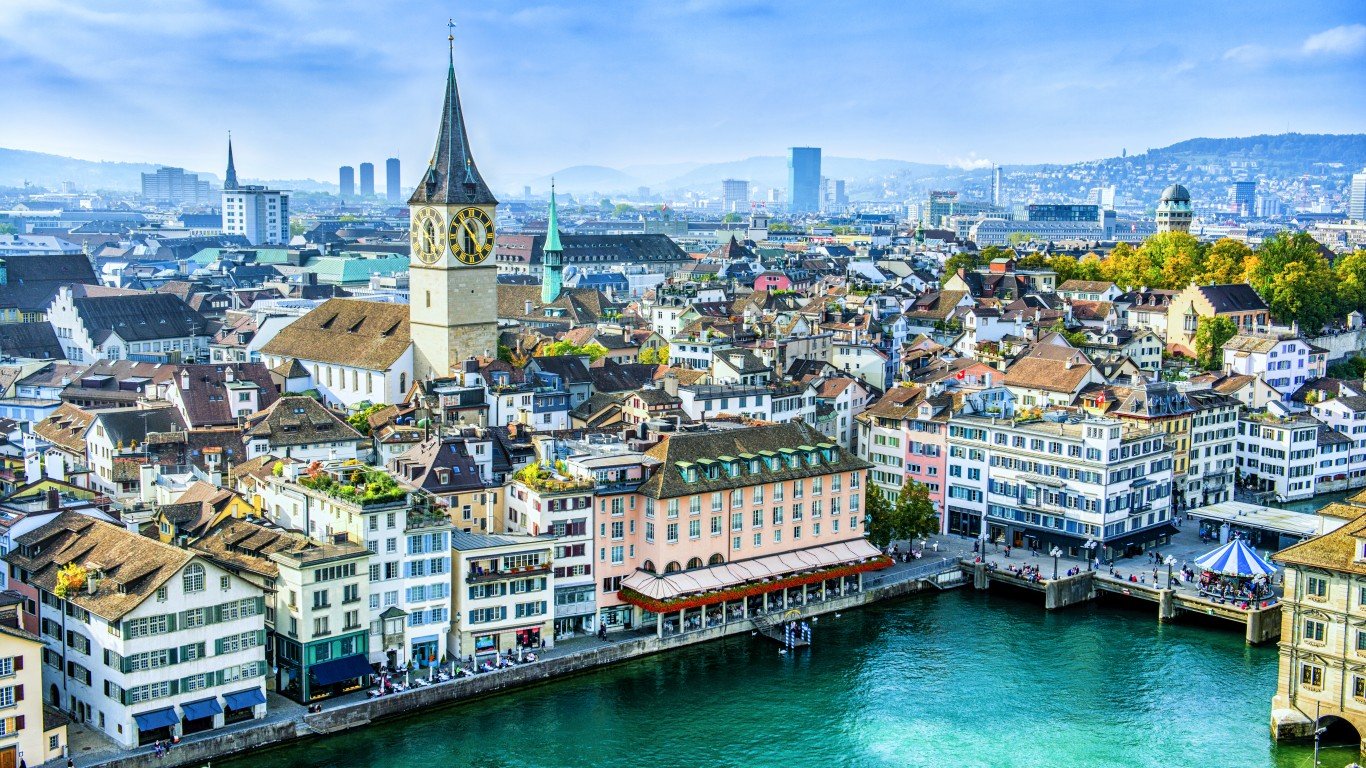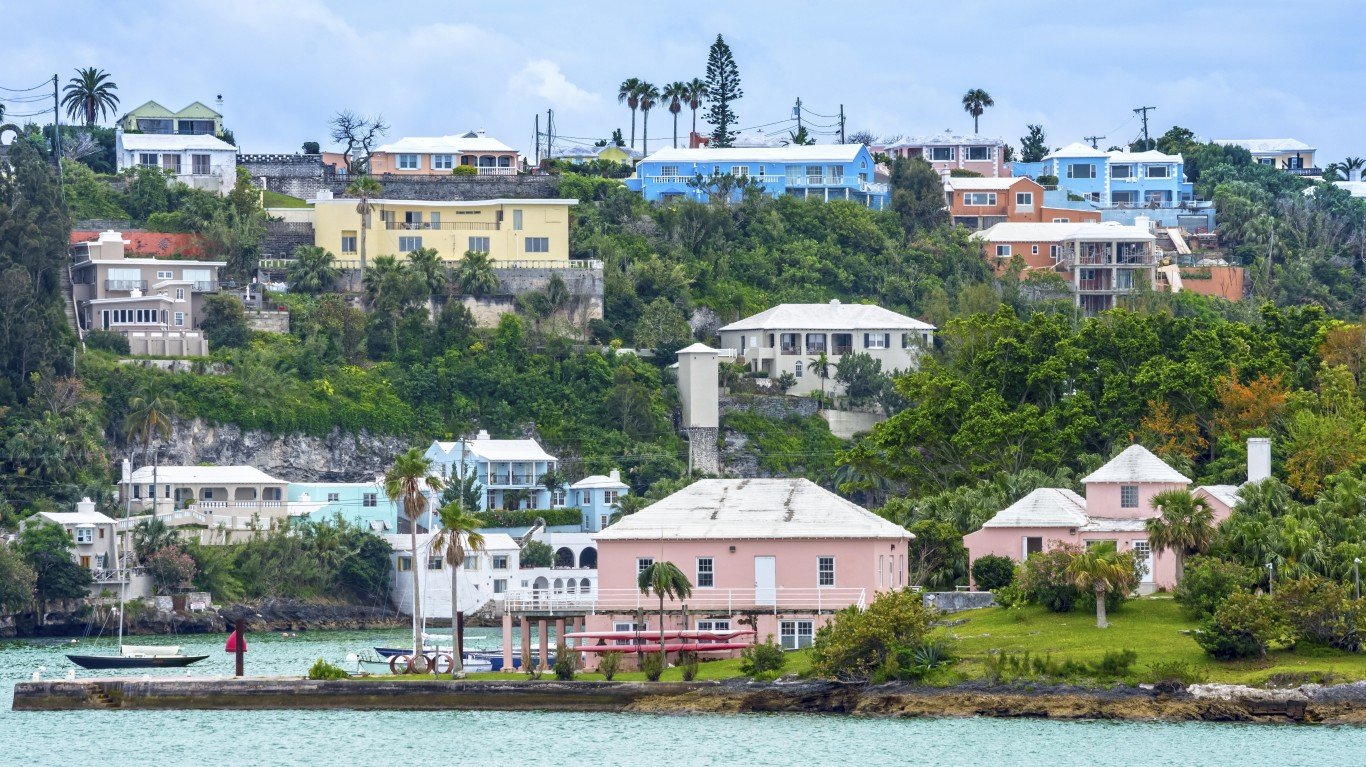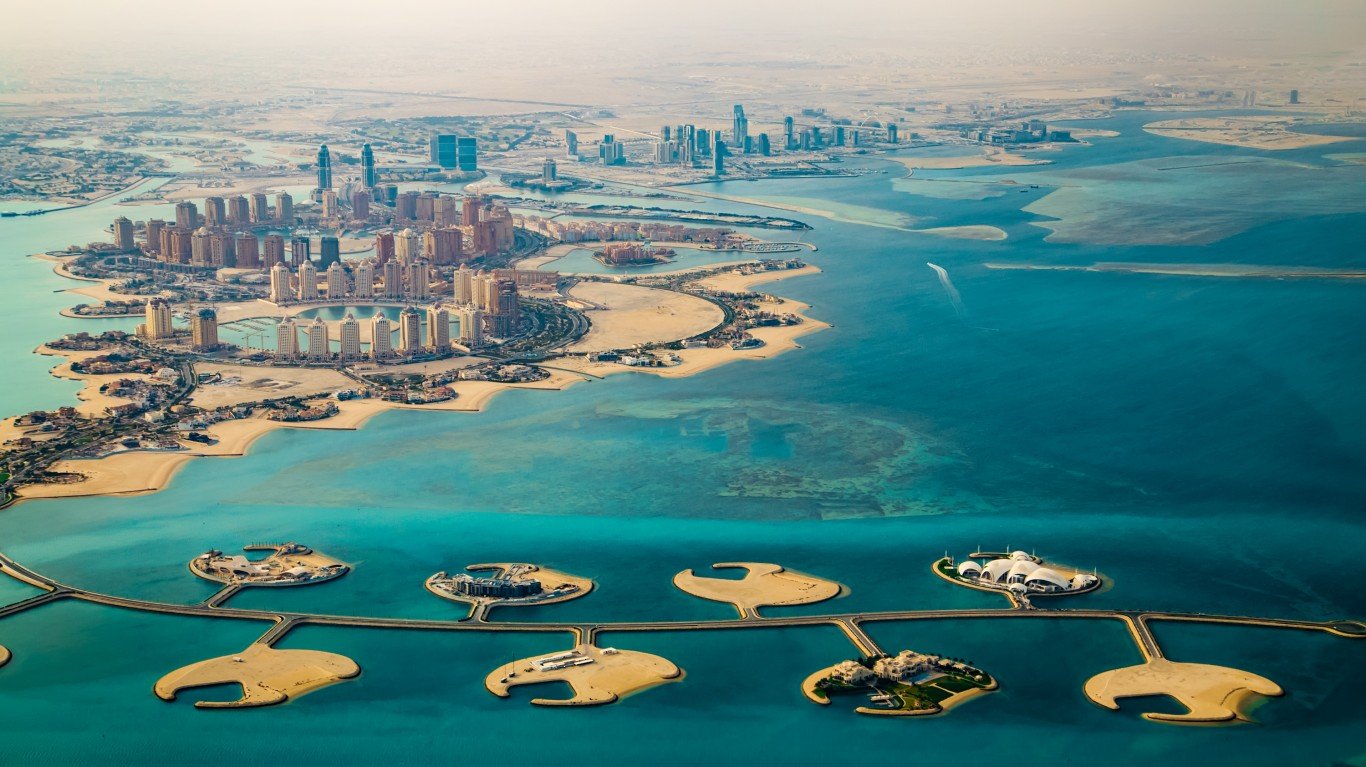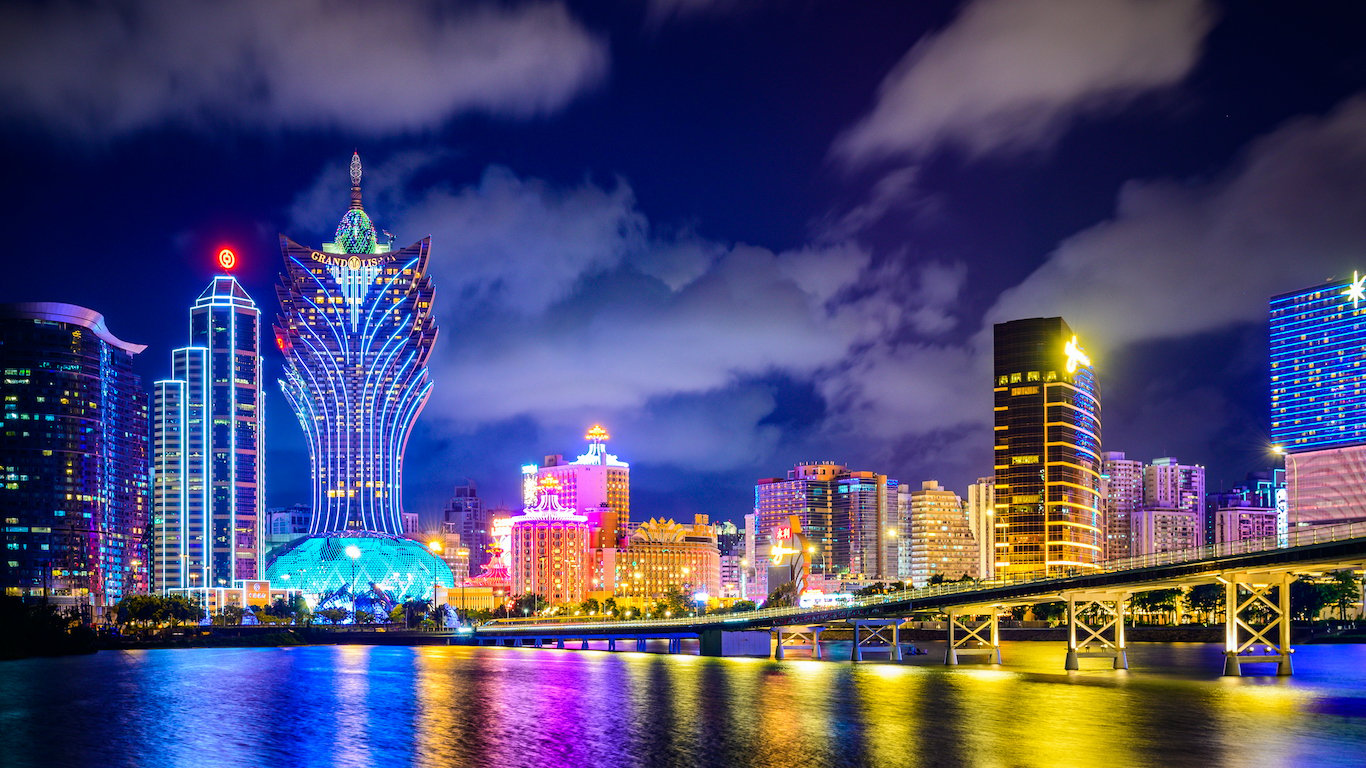

The United States is often referred to as the wealthiest nation on Earth. Measured by the size of its economic output, that is the case. However, by another widely-used measure, intended to reflect the nation’s wealth relative to the size of its population, the U.S. doesn’t even fall within the top 10.
Gross national income, or GNI, represents the sum of money earned by a nation’s people and businesses within a given year. Unlike GDP, GNI also measures income earned by corporations based in the country but operating outside its borders.
Global GNI per capita — all the income earned worldwide in 2019 — was $17,591. This figure is representative of the pre-tax income the average person earned and is indicative of the average quality of life. Worldwide, GNI per capita ranges greatly, and while in some countries it is a fraction of the global figure, in others it is more than triple the global average.
Using data from the World Bank, 24/7 Wall St. reviewed the GNI per capita of the 194 nations and special regions with available data to identify the 10 richest countries. GNI per capita figures for the most recent available year are calculated using purchasing power parity and are in current international dollars. These wealthiest countries span the globe from North America to Southeast Asia, though most are concentrated in Western and Northern Europe.
Most countries on this list share several common factors, including reliable infrastructure, trust in public institutions, extensive international trade, and effective management and leveraging of natural resources. While the majority of these countries have diversified, complex economies, some — particularly those in the Middle East — are almost entirely dependent on their oil wealth. These are the 15 countries that control the world’s oil.
One of the strongest correlations with income at a national level is the overall health of the population. Residents of wealthy countries tend to have better access to housing, education, nutrition, and health care — all factors that help to improve health outcomes. In every country on this list, life expectancy at birth is at least 2.4 years greater than the 72.6-year global average. Here is a list of the countries where people live the longest.
Click here to see the 25 richest countries in the world
Click here to see our methodology

10. Brunei Darussalam
> 2019 GNI per capita: $66,410
> 2019 GDP: $13.5 billion (134th out of 206 countries)
> Population (2019): 433,285
> Life expectancy at birth in 2018: 75.7 years
Brunei Darussalam is a small country in southeast Asia bordered by Malaysia and the South China Sea. Though the country has a relatively small economy of just $13.5 billion, it also has a small population of less than half a million people.
The country is oil rich, and petroleum gas and crude petroleum accounted for over 90% of its $6.4 billion in exports in 2018. With a well-educated population and high quality infrastructure, the country draws in considerable foreign investment. The country is in the process of diversifying its economy, expanding into IT manufacturing. Due in part to its wealth, residents do not pay income tax.
[in-text-ad]

9. Ireland
> 2019 GNI per capita: $68,050
> 2019 GDP: $388.7 billion (33rd out of 206 countries)
> Population (2019): 4.9 million
> Life expectancy at birth in 2018: 82.3 years
Ireland is the ninth wealthiest country in the world and the fourth wealthiest in Europe, with a GNI per capita just over $65,000. Ireland is one of the most trade dependent countries in the world. In 2018, the country exported $210 billion worth of services, the most of any country.
Ireland Ireland’s chief export, of the $175 billion in goods it sold in 2018, is chemical products, which include vaccines, cultures, and packaged medicines. More than a quarter of Ireland’s exports go to the U.S., and most of the rest go to other European countries.

8. Norway
> 2019 GNI per capita: $69,610
> 2019 GDP: $403.3 billion (31st out of 206 countries)
> Population (2019): 5.3 million
> Life expectancy at birth in 2018: 82.8 years
With a GNI per capita of nearly $70,000, Norway is the wealthiest Scandinavian country and the eighth wealthiest in the world. Its natural resources, which include fish, forests, minerals, and oil, are major drivers of the national economy. Norway is one of the world’s top exporters of oil and one of the top exporters of seafood.
Like other wealthy European countries, Norway provides a strong social safety net to citizens and has relatively little corruption and wealth inequality. Life expectancy at birth in the country is nearly 83 years, about a decade longer than the global average.

7. United Arab Emirates
> 2019 GNI per capita: $70,240
> 2019 GDP: $421.1 billion (30th out of 206 countries)
> Population (2019): 9.8 million
> Life expectancy at birth in 2018: 77.8 years
Like other Middle Eastern countries on this list, the United Arab Emirates derives its wealth largely from its natural resources — namely, oil. The UAE controls nearly 6% of the world’s proved oil reserves, and crude and refined petroleum exports generated nearly 40% of the country’s $242 billion in exports in 2018. The country is in the process of diversifying its economy, bolstering its trade and tourism sectors and focusing on improving education of its population.
The UAE struggles more than most countries on this list with income inequality and public sector corruption. It is also one of only five countries on this list where life expectancy at birth is less than 80 years.
[in-text-ad-2]

6. Switzerland
> 2019 GNI per capita: $72,390
> 2019 GDP: $703.1 billion (20th out of 206 countries)
> Population (2019): 8.6 million
> Life expectancy at birth in 2018: 83.8 years
Thanks in part to its competitive business environment and strong free trade climate, Switzerland is one of the wealthiest nations in the world. Its GNI per capita of $72,390 is the sixth highest in the world. The country is one of just 20 in the world with GDP that exceeded $700 billion in 2019.
Switzerland is the world’s leading exporter of gold — exporting $63.8 billion worth in 2018. Gold exports accounted for over one-fifth of its total exports that year. Switzerland is also one of the best educated countries in the world, with 36.9% of adults 25 and older holding at least a bachelor’s degree, or the equivalent.

5. Bermuda
> 2013 GNI per capita: $75,620
> 2013 GDP: $5.6 billion (157th out of 206 countries)
> Population (2019): 63,918
> Life expectancy at birth in 2018: 81.7 years
Home to fewer than 64,000 people, Bermuda is the smallest country on this list. With a GDP of only $5.6 billion, it also has the smallest economy. Still, at $75,620, GNI per capita in Bermuda is fifth highest in the world.
Bermuda’s economy is heavily dependent on insurance and financial services for international business. Tourism, driven by visitors from the United States, is also an economic pillar.
[in-text-ad]

4. Luxembourg
> 2019 GNI per capita: $77,570
> 2019 GDP: $71.1 billion (73rd out of 206 countries)
> Population (2019): 619,896
> Life expectancy at birth in 2018: 82.3 years
Luxembourg is one of the smallest countries in the world, both in terms of landmass and population, with just over 600,000 citizens. With a GDP of $71.1 billion, Luxembourg’s GNI per capita is one of the highest in the world, at $77,570.
Surrounded by Germany, France, and Belgium — all countries that rank on this list — Luxembourg is dependent on trade with its European neighbours. It also has a strong financial sector.

3. Singapore
> 2019 GNI per capita: $92,020
> 2019 GDP: $372.1 billion (35th out of 206 countries)
> Population (2019): 5.7 million
> Life expectancy at birth in 2018: 83.1 years
Formerly a British trading post, Singapore, a city state in southeast Asia is now a thriving economic powerhouse. Singapore’s economy is dependent on its financial and trade sectors. Its chief exports include electronics, petroleum products, chemicals, medical devices, and pharmaceuticals.
The country is largely unburdened by public sector corruption and has a well-educated population and low unemployment. It is one of only three countries in the world with a GNI per capita over $90,000.

2. Qatar
> 2019 GNI per capita: $94,170
> 2019 GDP: $183.5 billion (54th out of 206 countries)
> Population (2019): 2.8 million
> Life expectancy at birth in 2018: 80.1 years
Qatar has the second highest GNI per capita in the world at $94,170 — more than five times the worldwide GNI per capita. Like many other Middle Eastern countries to rank among the richest in the world, Qatar’s wealth is largely derived from significant oil and gas production. Qatar exported $59 billion-worth of gas and petroleum in 2018, mostly to Asian countries like South Korea, India, and China.
Qatar is one of the fastest growing countries in the world, with a population growth rate of 10.4% from 2015 to 2019 — more than double the worldwide rate.
[in-text-ad-2]

1. Macao SAR, China
> 2018 GNI per capita: $123,290
> 2019 GDP: $53.9 billion (85th out of 206 countries)
> Population (2019): 64,445
> Life expectancy at birth in 2018: 84.1 years
Macao is a special administrative region of China. Though it is officially a part of China, it has broad authority over its own government and economy. Home to fewer than 65,000 people, Macao is one of the smallest countries on this list. Still, with a $53.9 billion economy, Macao’s GNI per capita of $123,290 is higher than that of every other country in the world.
Macao’s economy is almost entirely dependent on its service sector. Since foreign casinos were allowed to operate there in 2003, tourism and gaming have come to account for more than 90% of the economy.
Methodology:
To determine the richest countries in the world, 24/7 Wall St. reviewed data on GNI per capita for 194 countries and special regions with available data from the World Bank. The World Bank estimates GNI per capita using the purchasing power parity method, and figures are in current international dollars. All data on GNI per capita is based on the most recent available year for a given country.
Additional data on GDP in current U.S. dollars, population, and life expectancy at birth also came from the World Bank. All data are for the most recent year available for every country.
We also considered data on levels of public sector corruption from the nonprofit, international watchdog and anti-corruption group, Transparency International.
Take This Retirement Quiz To Get Matched With An Advisor Now (Sponsored)
Are you ready for retirement? Planning for retirement can be overwhelming, that’s why it could be a good idea to speak to a fiduciary financial advisor about your goals today.
Start by taking this retirement quiz right here from SmartAsset that will match you with up to 3 financial advisors that serve your area and beyond in 5 minutes. Smart Asset is now matching over 50,000 people a month.
Click here now to get started.
Thank you for reading! Have some feedback for us?
Contact the 24/7 Wall St. editorial team.
 24/7 Wall St.
24/7 Wall St. 24/7 Wall St.
24/7 Wall St.


